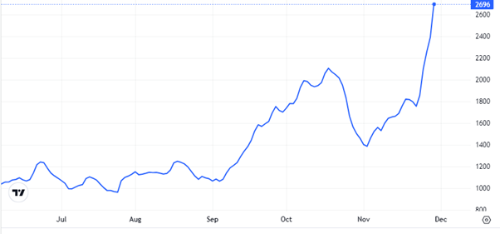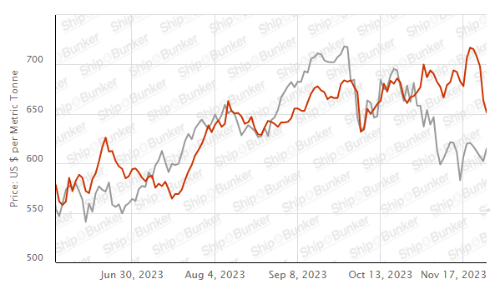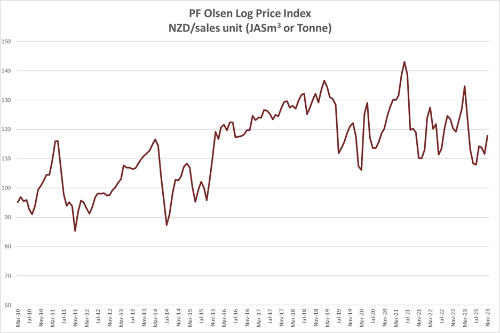
The November AWG prices for export logs increased an average of $12 per JASm3 from October prices. North Island prices increased about $10 while prices in most South Island ports increased more, albeit from a lower base. Log demand in China continues to remain steady with log inventory at extremely low levels. The AWG price increases were due to a mixture of a weaker NZD against the USD, slightly lower shipping costs and increases in sale prices in China.
New Zealand’s domestic demand for sawn timber has had a post-election boost with an increase in construction projects for the coming summer and a good export crop of kiwifruit requiring wooden pallets for export.
The PF Olsen Log Price Index increased $6 to $118. The index is currently $1 below the two-year average and $4 below the three-year and five-year averages.
Domestic mills report an increase in sawn timber demand as construction gears up for summer. Stocks of sawn timber have been depleted throughout the supply chain as well, so this is being built up again increasing demand. Some truss and frame manufacturers report they are booked-up until March next year. The kiwifruit yield in New Zealand has been much higher than last year so there is strong demand for material to make pallets.
Sales of sawn timber to Asia are holding up okay with some slight price increases as well.
Export Log Markets
China
The sale price for A grade pine logs in China is now in the range 125-130 USD per JASm3. China radiata log inventory remains about the same as last month around 1.7-1.8m m3, with total softwood inventory at about 2.3m m3. Daily port off-take has remained within the range of 65-70k m3 per day.
In mid-November the Chinese government announced a 127 billion USD stimulation package involving low-cost financing for urban village renovation and affordable housing programs. The Peoples Bank of China will facilitate banks injecting funds in phases into the economy. This is expected to trigger construction activity. There is still a fundamental issue in that the Chinese population doesn’t see real estate as a good investment, as they don’t think values will rise. So this may increase supply more than demand, which won’t improve value. At least the Chinese government is taking steps to create activity in this sector which is a good sign.
The China Caixin Manufacturing PMI dropped from 50.6 in September to 49.5 in October (Any PMI number above 50 signals manufacturing growth). This reading indicates the first contraction in manufacturing activity since July.
Demand for green sawn timber in Gandhidham is subdued after the Diwali festival period, with prices at 481 INR per CFT for South American pine and 511 INR per CFT for Australian pine. Bulk log shipments have also arrived from South Africa after a lull. Kandla Port is receiving an oversupply of pine logs and log demand may remain subdued till early 2024. The MV Sarika Naree arrived at Kandla Port with about 43,000 m3 of logs from New Zealand and has been underdeck cargo fumigated, degassed and berthed. Discharge has commenced and should finish about 5th December. There were no logs stored on-deck, so financial analysis for the export viability will consider ‘dead freight’ for on deck portion, extra time for fumigation and degassing at Kandla and fumigation cost.
Tuticorin is experiencing rains and demand should increase in January. South Africa is facing Methyl-bromide fumigation issues and container shipments from Durban to Mundra and Tuticorin ports have been affected.
Exchange rates
The NZD has strengthened against the USD through November, but this will be offset by log price increases in China. The CNY has also strengthened against the USD so the buying power of the Chinese log buyers has improved.

NZD:USD

CNY:USD
Ocean Freight
Freight costs have dropped slightly with average shipping costs now about 30 USD per JASm3 to ship logs from the North Island of New Zealand to China.
The Baltic Dry Index has risen again in November.
The Baltic Dry Index (BDI) below is a composite of three sub-indices, each covering a different carrier size: Capsize (40%), Panamax (30%), and Supramax (30%). It displays an index of the daily USD hire rates across 20 ocean shipping routes. Whilst most of the NZ log trade is shipped in Handysize vessels, this segment is strongly influenced by the BDI.

Source: TradingEconomics.com

Singapore Bunker Price (VLSO) (red line) versus Brent Oil Price (grey line)
Source: Ship & Bunker
PF Olsen Log Price Index – November 2023
The PF Olsen Log Price Index increased $6 to $118. The index is currently $1 below the two-year average and $4 below the three-year and five-year averages.

Basis of Index: This Index is based on prices in the table below weighted in proportions that represent
a broad average of log grades produced from a typical pruned forest with an
approximate mix of 40% domestic and 60% export supply.
Indicative Average Current Log Prices – November 2023
| Log Grade | $/tonne at mill | $/JAS m3 at wharf | ||||||||||
| Nov-23 | Oct-23 | Sep-23 | Aug-23 | Jul-23 | Jun-23 | Nov-23 | Oct-23 | Sep-23 | Aug-23 | Jul-23 | Jun-23 | |
| Pruned (P40) | 175-200 | 175-200 | 175-200 | 175-200 | 175-200 | 175-200 | 180 | 180 | 180 | 183 | 150-160 | 150-160 |
| Structural (S30) | 120-145 | 120-145 | 120-145 | 120-145 | 120-145 | 120-145 | ||||||
| Structural (S20) | 93-100 | 93-100 | 93-100 | 93-100 | 93-100 | 93-100 | ||||||
| Export A | 125 | 119 | 119 | 120 | 105 | 105 | ||||||
| Export K | 116 | 110 | 110 | 111 | 96 | 96 | ||||||
| Export KI | 107 | 101 | 101 | 102 | 89 | 89 | ||||||
| Export KIS | 98 | 92 | 92 | 93 | 80 | 80 | ||||||
| Pulp | 46 | 46 | 46 | 46 | 46 | 46 | ||||||
Note: Actual prices will vary according to regional supply/demand balances, varying cost structures and grade variation. These prices should be used as a guide only.
A longer series of these prices is available here.
Log Prices
Select chart tabs
This article is reproduced from PF Olsen's Wood Matters, with permission.

We welcome your comments below. If you are not already registered, please register to comment.
Remember we welcome robust, respectful and insightful debate. We don't welcome abusive or defamatory comments and will de-register those repeatedly making such comments. Our current comment policy is here.